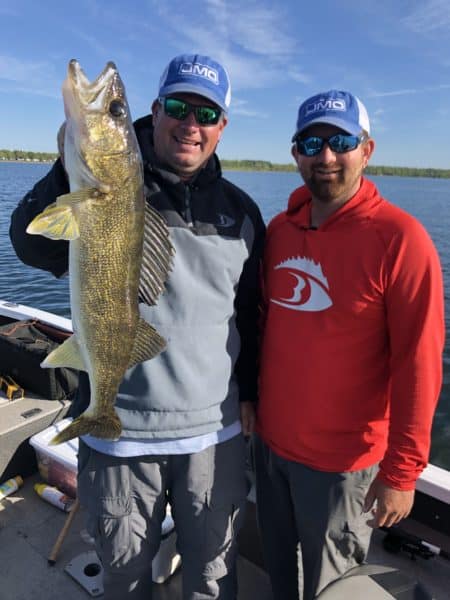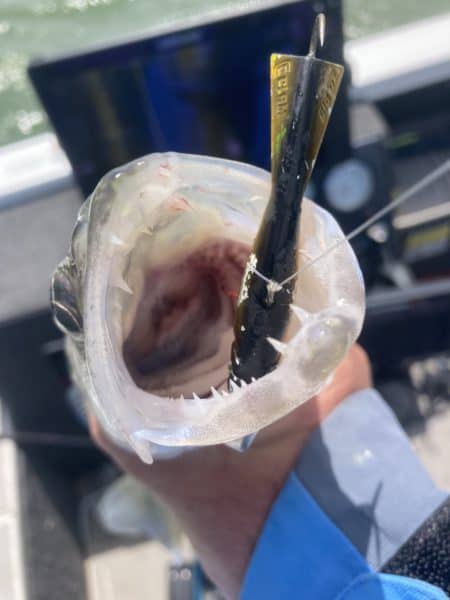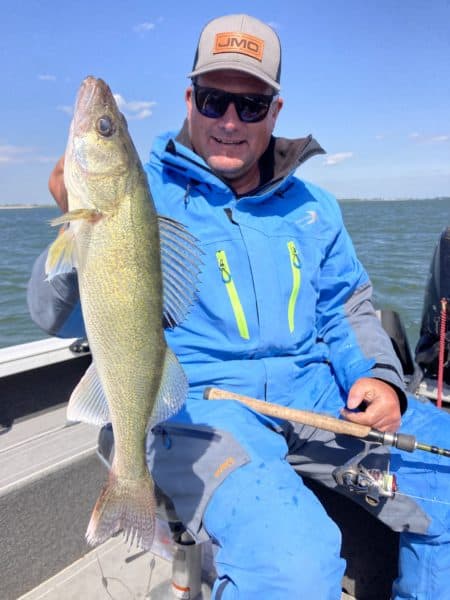Glide Baits for Fall Walleye – JMO
Category: article
Aug 31st, 2021 by Keith Worrall
Modified Aug 31st, 2021 at 1:51 PM

Glide Baits for Fall Walleye
By Jason Mitchell
Over the past half dozen years, glide baits or jigging minnows like the classic Jigging Rap, Flat Rap, Tikka Mino, Shiver Minnow and Hyper Glide have become extremely popular with walleye anglers. While these heavy horizontal profile lures can be fished in shallow water, the weight of these lures gives them the added versatility of casting or jigging over deep water. Come mid to late summer and well into the fall, this category of lures can be fished with pinpoint precision over specific pieces of structure like deep boulders and rock or used to cast at specific fish if you are using Active Target or Live Sight.
This presentation has gotten plenty of attention but many anglers still haven’t tried this presentation or just don’t have any confidence. Of course, the best way to get confidence is to catch some fish with this presentation. In order to use these lures effectively, we are going to highlight a few aspects we believe are important and explain some of the nuances to fishing these lures effectively. We will also explain a few of the mistakes we made personally.
Now you can cast and cover some water but this lure category shines whenever you are working in tight spaces. Say you have fish bunched up in a current spot between two islands in the fall, maybe the fish are piled onto a specific side of a deep point or using an isolated rock pile in the basin… all top fall locations. When fish are bunched up, you can often turn them on with glide baits and glide baits just seem to trigger a reaction we don’t often see with other presentations. Now to be fair, no lure category simply shines every day all the time but there have been so many times when we pulled our hair out to catch fish we were marking with traditional jigs and rigs yet witnessed the most violent walleye strikes when we switched up to glide baits.
For water deeper than twenty feet, I am a big fan of using braided like eight-pound Fireline. Some anglers prefer to use mono and I like mono when I am pitching these lures in less than ten feet of water but in deeper water, I feel like I get better hookups using braid. Below the braid, I use a small barrel swivel to combat line twist and prefer a heavier 10–14-pound fluorocarbon leader that is two to three feet long. The rod is important. I prefer a medium fast action rod that I can really pop the lure with when I snap the rod. The rod needs to be fast enough where it doesn’t load up when you snap the lure. As you snap the lure, each rod snap is basically a hook set as many fish will hit between snaps and pin the bait to the bottom.
The cadence can vary somewhat from day to day and each lure will seem to have a sweet spot as far as the stoke height and velocity of the snap. By and large, many walleye anglers trying to learn this system don’t snap these lures hard enough to trigger the reaction bite. We are often snapping these baits hard enough where you can hear the rod snap forward. On average with many lures, we are snapping the baits a few feet or more. Most of these lures seem to catch more fish if there is some slack on the fall. Let the lure snap forward and fall on slack line. Often, we let them hit the bottom and slack line as they hit. Often, fish will hit at the bottom of the glide on slack line or pin the lure to the bottom. As you snap the rod forward, the fish are just on. This is why the rod is so important. Each snap could be a hook set so the snap forward must have enough power to set the hook.

When I first started using glide baits, I caught a few fish but it took a while to figure out the cadence and snap. Once I started snapping the lure much harder and more aggressively, I began catching way more fish.
As you position the boat and cast, it often seems to work better if you position the boat deep and cast shallower, working the lure from shallow to deep. Let the lure snap and glide down the structure when possible as it seems like the lures snag up much less.
If you are fishing a hard bottom with rock and boulders, you can clip off the front hook that is on most glide baits and if you fish a lot of rock, you will love the solid Zink construction of the Tikka Mino as there are no plastic fins to break on this lure. Some anglers will also reinforce the plastic fins of their glide baits with super glue.
The other component that makes this presentation so effective is using your electronics to catch specific fish or at least make casts towards specific groups of fish. What is amazing when using active sonar is just how far fish will follow a lure and the distance some fish will travel to hit the lure. I have my Active Target transducer mounted to a Brew City mount so I can pan and look for fish. There are many times when I can watch the glide bait come through the fish. Probably the only learning curve to using this technology is learning to cast beyond the fish so that the lure can work in front of a fish on a cast. Another phenomenon that often happens if you spot lock over a location and cast around the boat is the number of fish that eventually accumulate below the boat. I find that I often catch fish right below the boat and many fish will follow until the lure gets below the boat so don’t be afraid to fish below the boat at the end of a cast.
When a fish eats a glide bait, there won’t be a doubt in your mind. To be fair, this presentation resembles blade baits in that you will snag some fish or catch some fish outside the mouth especially when the fish are pinning the lure to the bottom. What is always surprising however is just how far some of these fish choke down these lures. Despite the wild snap up off the bottom and the erratic glide back down to the bottom, most fish will simply swallow the lure. The lure is just gone.

Fall walleye often stack up on specific pieces of structure and walleye are notorious for using sharp breaking structure in the fall. Glide baits enable you to trigger fish while still positioning on spot on the spot locations and enable you to work up or down this structure with a presentation that brings out an aggression. Build confidence with this presentation and you are going to put more fall walleye in the boat.
Caption for photo:
JPG_0517: For triggering fish on spot on the spot locations, this presentation shines in tight quarters. Glide Baits are deadly for fall walleye.
IMG_3904: The author Jason Mitchell posing with a big Minnesota walleye with guide Matt Klug. Glide Baits are gaining in popularity for good reason as they simply catch big fish.
IMG_0509: For fishing over rock and boulders, the solid metal construction of the Tikka Mino is much more durable than glide baits with traditional plastic fins. A common mistake some anglers make when fishing with glide baits is simply not being aggressive enough. Snap the lure hard and let the lure fall on slack line. Each snap forward is a potential hook set as many fish eat the lure as it falls or pin the lure to the bottom.